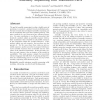Free Online Productivity Tools
i2Speak
i2Symbol
i2OCR
iTex2Img
iWeb2Print
iWeb2Shot
i2Type
iPdf2Split
iPdf2Merge
i2Bopomofo
i2Arabic
i2Style
i2Image
i2PDF
iLatex2Rtf
Sci2ools
SMA
1995
ACM
1995
ACM
Assembly sequencing with toleranced parts
The goal of assembly sequencing is to plan a feasible series of operations to construct a product from its individual parts. Previous research has investigated assembly sequencing under the assumption that parts have nominal geometry. This paper considers the case where parts have toleranced geometry. Its main contribution is an e cient procedure that decides if a product admits an assembly sequence with innite translations that is feasible for all possible instances of the components within the speci ed tolerances. If the product admits one such sequence, the procedure can also generate it. For the cases where there exists no such assembly sequence, another procedure is proposed which generates assembly sequences that are feasible only for some values of the toleranced dimensions. If this procedure produces no such sequence, then no instance of the product is assemblable. This work assumes a simple, but non-trivial tolerance language that falls short of capturing all imperfections of...
| Added | 26 Aug 2010 |
| Updated | 26 Aug 2010 |
| Type | Conference |
| Year | 1995 |
| Where | SMA |
| Authors | Jean-Claude Latombe, Randall H. Wilson |
Comments (0)

